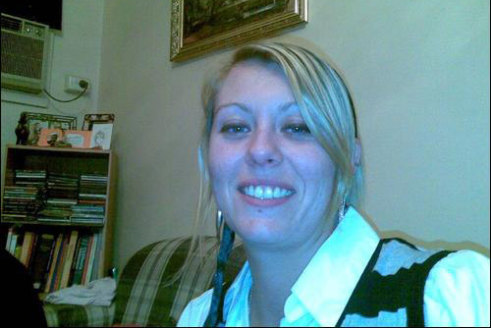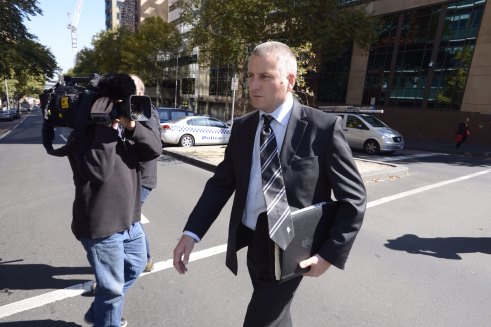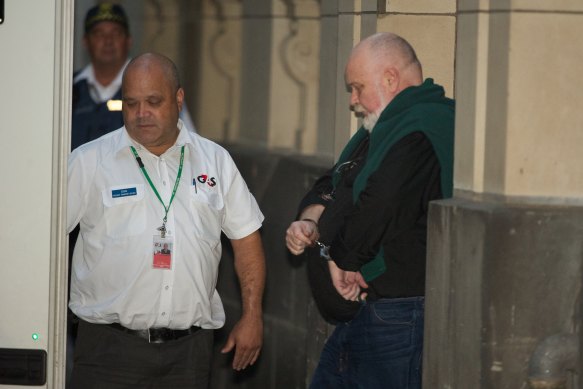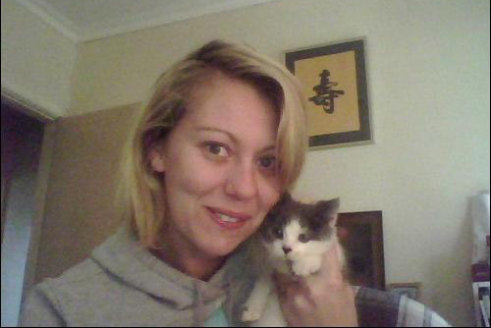- Analysis
- National
- Victoria
- Naked City
How the tide turned on Phillip Island killer
The man in the northern suburbs police station seemed to have all the answers, which was hardly surprising. He had been through this process a few times before.
Smart, calm and with the appearance of a gentle grandfather, John Leslie Coombes seemed happy to assist. After all, a friend of his had been murdered, and without the help of fluky tides, her remains may well have never been discovered.

DNA testing confirmed the remains were from missing Epping woman Raechel Betts.
On August 16, 2009, a man jogging along the beach at Newhaven on Phillip Island found a severed left leg about 50 metres from the San Remo Bridge. The following day, crew from the Sorrento ferry reported seeing a human leg in the water. It was never recovered.
Two weeks later more human remains were discovered by another jogger about 30 kilometres away at Ventnor Beach. A distinctive tattoo and subsequent DNA tests established they were from missing woman Raechel Renee Betts.
Coombes would tell police he saw himself as a father figure to Betts, but the man who looked like Father Christmas had a dark past. He had murdered twice before.
The two homicide detectives, Tim Day and Leigh Smyth, interviewing Coombes found him “very personable”.
“At that point he was a person of interest but not a suspect,” Day recalls.
While Coombes may have thought he had all the answers, he didn’t know all the questions. “I looked at Leigh, and we both thought we needed to have a closer look at this bloke.”
The bloke in question was a cold-blooded killer, a butcher and a liar.
Coombes would give several self-serving versions of what happened before pleading guilty to murder. Finally, his papers were marked to never be released.
While the murders he committed were all different, his stories were disturbingly similar. He was always the white knight trying to avenge some form of injustice – and then things just got out of hand. “He liked to see himself as a protector when he was the opposite,” says Smyth.

Tom Hogan outside court in 2015.Credit: Justin McManus
For well-respected detective Tom Hogan it was his first job in homicide and, as is the tradition, he became the lead investigator.
“It was one of the most horrendous jobs any of us had seen,” says Day. Hogan would become a rock-solid homicide squad member for many years, then an instructor at Detective Training School.
“Tom was magnificent at building trust with Raechel’s friends and the family. He had a caring gentle nature, but he was also like a dog with a bone. He was never satisfied and would always ask why.”
Always determined, he took to fitness later in life. Tragically, he died while competing in a Queensland triathlon on November 5 last year.
The mystery is not that Coombes killed Raechel Betts; the mystery is that having been convicted of two separate murders he was released to kill again.
Coombes was born in September 1954, left school at 15, and became an apprentice mechanic, joining the army, where he stayed until injured in a truck smash.
In November 1984, he murdered Henry Desmond Kells in the victim’s Edithvale bungalow. He claimed to have intended to beat Kells for some slight against a mutual friend, lost control and repeatedly stabbed him.
His lack of control, the court was told, was due to the head injury he sustained in the army truck smash. He was sentenced to a minimum of 11 years.
What the court didn’t know was that he had killed another man nine months before murdering Kells.

John Coombes (right) leaves the Melbourne Supreme Court in 2011.Credit: Photographic
In February 1984, Coombes, and another man took Michael Speirani on a boat trip, luring him on the pretence of buying his car. Again Coombes claimed he only intended to beat him, then throw him overboard before dragging him back onto the boat as punishment for a supposed sexual attack on a 15-year-old girl.
Instead, he stabbed Speirani, threw him overboard and used the boat’s propeller to chop up the body that was never found.
He was convicted of the second murder in 1998 and paroled in 2007 to soon become a drug trafficker.
Raechel Betts was, according to Smyth, “just a decent person who became wrapped up in the drug world”.
Born in 1982, she went to a private school and lived with her grandparents in Ivanhoe before graduating as a school teacher with early learning qualifications. She worked in child care until 2008, when her drug habits and mental health issues led her to drop out and become a small-time trafficker. Coombes became one of her suppliers.
As her life spiralled, she still cared for others. While in a long-term relationship, she learnt she couldn’t have children. Later she was introduced to two at-risk girls aged 13 and 15 and became their unofficial carer. “She was their mother figure,” says Smyth.
In August 2009, Betts told friends she was going with her boss on a fishing trip. On August 10, a friend heard her on the phone talking to a man called John in a coded conversation about drugs.
The following day she packed an overnight bag, telling the girls in her care she was going on a fishing trip and would be back within 48 hours. She drove to West Heidelberg, parked her car outside a friend’s house, then walked to the nearby Waterdale Road shops to meet Coombes.
At 9.11pm he rang Nicole Godfrey, a girlfriend who lived in a three-bedroom house on Phillip Island, saying he was heading there with a friend. His car later pinged on EastLink on the way to the island.
Some time that night at the house, Coombes strangled Betts. Why is still not known.
The confident Coombes told police he had nothing to do with her murder. He produced an alibi witness who said he had seen Coombes in Melbourne on the night of the 11th and again the next day. Plus Godfrey would tell police that her car had broken down in Cranbourne, and she rang Coombes for help. This would provide an innocent explanation for the calls and his car pinging on EastLink.
But as the alibis fell apart Coombes told another story. He had been convinced by Betts to murder three men who had raped the two girls in her care. As in the previous murder cases, Coombes painted himself as the white knight prepared to kill rapists.
Then, when they were at the Phillip Island house, he claimed Betts said she had pimped the two girls out as a way of paying off her drug debts. “Girl’s got to pay her debts,” Coombes claimed she said.
Outraged, he lost control and strangled her in her bed.

Raechel Betts was devoted to the two teenagers in her care.
The claims were complete nonsense. Police say while she struggled with drugs and mental illness, she was devoted to the two teenagers in her care.
Coombes was an experienced boater, fisher and killer. He knew about tides, currents and the wave movements in Port Phillip and Western Port bays.
And having disposed of the body of Speirani in one of the bays, he saw no reason why it wouldn’t work again.
He dragged Betts’ body into the bath and spent hours dismembering her. While initially Godfrey (probably due to fear) gave Coombes an alibi, police continued to work on her until she gave a second version.
“I know she was chopped up in the bathroom. He took her in the bathroom because I was in bed and I had the TV on a little bit, and I had my hands in my ears so I couldn’t hear anything, and I’ve just wiped it all from my memory just to be able to cope with it.”
Coombes would tell police he vomited several times, but the weight of evidence is he enjoyed his work, asking Godfrey, “Do you want to come in and do a dissection or have a look at anything?”
He put the remains in garbage bags, then in Godfrey’s car, drove to the Newhaven pier to dump the body parts, the victim’s clothes, knives and the garbage bags in the fast flowing water. He returned to scrub the bathroom with bleach.
But the tide and his luck changed, and one leg eventually swept up on the beach. From that moment, it was only a matter of time.
Despite persuading three people to give alibis, he was arrested two months later. He pleaded guilty on the first day of the trial – not because he wanted to tell the truth but because he knew the case was overwhelming.
Justice Geoffrey Nettle sentenced Coombes to life without parole. “I am clear that this is one of those very exceptional cases where the evidence establishes beyond reasonable doubt that you are sufficiently likely to commit further murders that you should spend the remainder of your life in jail.”
It came as no surprise to the man with no conscience. In one bugged conversation, he predicted his own future.
“Believe me, I haven’t lost sight of the fact that, you know, three strikes you’re f---ing out, boy.”
What is the point of having a newspaper column if you can’t use it to pump up your own tyres? Our little book Naked City has managed to blunder into the shortlist for the Sydney Crime Writers Festival People’s Choice Award. Here is the link to vote.
https://docs.google.com/forms/d/e/1FAIpQLScXEhnPjMA1NbbM1UzYR_1X_wSb85YRHlQfAdlDd3lA8O2WWw/viewform
John Silvester lifts the lid on Australia’s criminal underworld. Subscribers can sign up to receive his Naked City newsletter every Thursday.